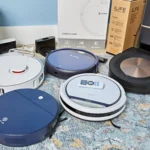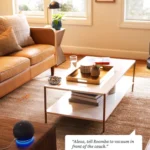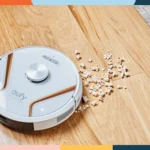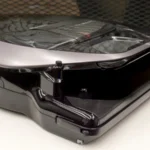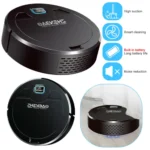Have you ever struggled to keep up with household chores, especially when it comes to cleaning? With the increasing popularity of smart home technology, you can now automate your cleaning routine with the help of a smart vacuum cleaner. However, to fully realize the benefits of this technology, efficient communication between devices is required. This is where smartphone app control comes into play, allowing for improved smart home integration for vacuum cleaners. In this article, we’ll explore the advantages of smartphone app control for smart vacuum cleaners, and discuss the future possibilities of this technology.
Smart Home Integration for Vacuum Cleaners
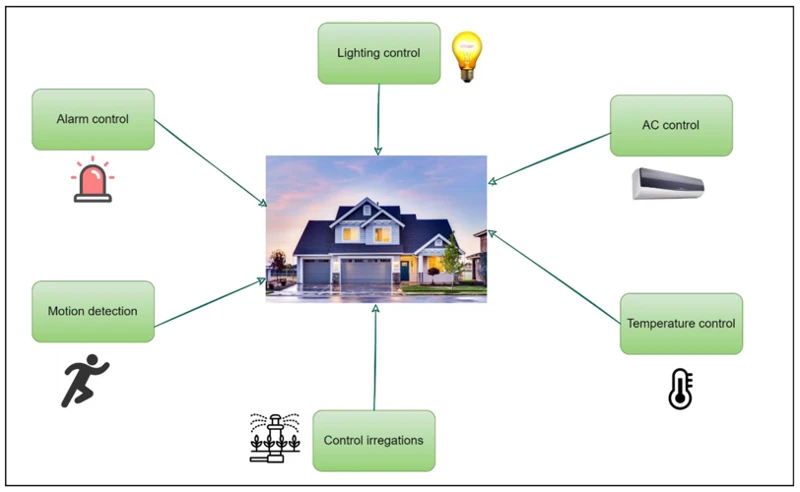
In today’s world, technology is constantly changing and evolving, and the way we clean our homes is not an exception. One such innovative technology has been the development of smart vacuum cleaners that are integrated into our smart home systems. With the help of efficient communication between devices, these intelligent machines are now able to maintain a clean home autonomously. The integration of smart vacuum cleaners with our smart homes has brought about numerous advantages, and the control of these devices has never been easier with the development of smartphone apps. In this section, we’ll explore the various features of smart home integration for vacuum cleaners, including the need for efficient communication between devices and connecting with other smart devices in the home. To see a full list of advantages of smartphone app-controlled vacuums, check out our advantages vacuum app section.
The Need for Efficient Communication Between Devices
Efficient communication between devices is crucial for successful smart home integration for vacuum cleaners. With multiple devices connected to the same network, it’s critical that they can communicate with each other in real-time to operate seamlessly.
One of the main concerns of smart home integrations is handling the diverse protocols and interfaces that various devices operate on. Vacuum cleaners need to be able to integrate into a smart home system and communicate with other compatible devices to ensure a smooth operation.
Interoperability is another key factor in efficient communication between devices. Vacuum cleaners need to use protocols or standards that enable them to communicate, such as Wi-Fi, Bluetooth, and Zigbee. Without it, communication between devices can become problematic, and there can be interoperability issues leading to poor performance.
There’s a need for data interchange among connected devices to facilitate automation and coordination. For instance, when a smart vacuum cleaner detects that the room is empty, it can communicate with other smart devices such as lights and thermostats to optimize energy consumption and create a more pleasant living environment.
To ensure efficient communication between devices in a smart home, there’s a need for a centralized platform that can manage and coordinate all smart devices efficiently. This platform includes the smartphone app, which enables users to access and manage their smart vacuum and other smart devices at any time from anywhere.
Through the smartphone app, users can obtain vital information about their vacuum’s performance and status updates, allowing them to make informed decisions about their home’s cleaning routine. Also, they can view device usage statistics and plan for upcoming cleaning requirements to ensure optimal cleaning with minimal hassle.
Efficient communication between devices is critical for successful smart home integration, which is why protocols, interoperability, data interchange, and centralization should be top-of-mind when implementing a smart vacuum in your home. For tips on how to effectively manage your smart vacuum through a smartphone app, check out our Smart Vacuum App Tips.
Connecting with Other Smart Devices in the Home
With the growing popularity and adoption of smart home technology, connecting (link to /integrate-smart-vacuum-alexa-google/) a smart vacuum cleaner to other smart devices in the home has become essential. Smart vacuums can now easily integrate with other devices such as smart thermostats, lighting systems, and security cameras. This integration allows them to work together seamlessly, making housekeeping tasks easier for homeowners.
For instance, homeowners can integrate their smart vacuum with a smart thermostat, such as Google Nest, to control the temperature of their home based on cleaning schedules. The smart thermostat can turn off the air conditioner or heater when the smart vacuum is in use, to prevent energy wastage. Additionally, smart vacuum cleaners can also connect with virtual assistants such as Amazon Alexa or Google Assistant, allowing users (link to /integrate-smart-vacuum-alexa-google/) to control the smart vacuum through voice commands.
Connecting a smart vacuum with a smart lighting system can also make cleaning tasks more efficient. For example, the lighting system can automatically turn on when the smart vacuum starts cleaning, providing better visibility and making it easier for the smart vacuum to navigate through the home. Homeowners can also connect their smart vacuum with their security cameras and receive notifications (link to /exploring-smart-vacuum-capabilities/) when their smart vacuum detects an obstacle or completes its cleaning task.
Connecting a smart vacuum cleaner to other smart devices in the home can make cleaning a more comfortable, seamless, and enjoyable experience for homeowners. As smart home technology continues to evolve, there is no limit to the new and innovative ways smart vacuum cleaners can integrate with other devices in transforming home cleaning for the better. (link to /smartphone-app-controlled-vacuum-cleaners-future-home-cleaning/)
The Advantages of Smartphone App Control
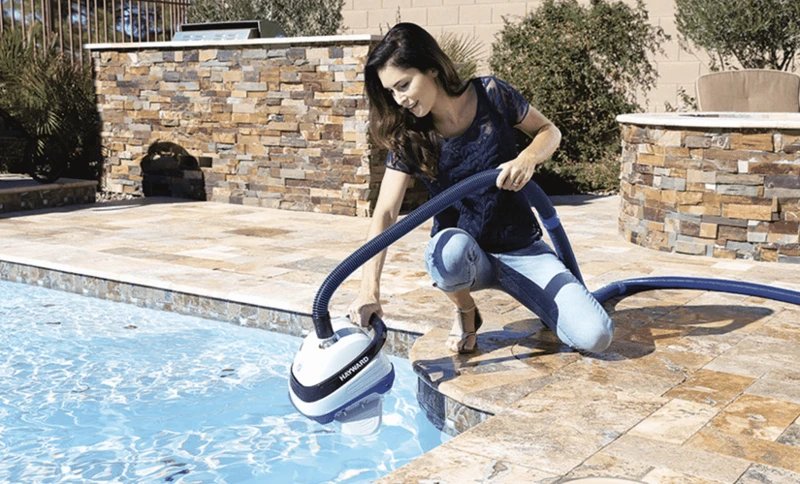
In today’s tech-savvy world, smartphones have become an integral part of our lives. Almost everything can be controlled using an app on your phone, be it ordering food, booking a cab, or even managing your home appliances. The role of smartphones has increased exponentially in recent years, and now, they are the perfect tool for managing your smart home. When it comes to vacuum cleaners, smartphone app control has revolutionized cleaning. Using these apps, you can not only control your device but also customize and automate its features. In this section, we’ll take a closer look at the advantages of smartphone app control for vacuum cleaners and how it is transforming the way we clean our homes. So, let’s dive in!
If you want to learn more about the features of a smart vacuum app, check out our comprehensive smart vacuum app guide.
Remote Control Accessibility
Smartphone app control has revolutionized the way we clean, giving us the ability to control and monitor our smart vacuum cleaners from anywhere at any time. With remote control accessibility, users can easily interact with their devices and streamline the cleaning process with just a few taps on their smartphone.
One of the most significant advantages of using smartphone app control in smart vacuum cleaners is the ability to give users complete control over the device no matter where they are. With remote access, users can start or stop the cleaning process, pause or resume suction, and navigate the vacuum cleaner around the house, all with just a few taps on their mobile devices.
To better understand the benefits of remote control, we have created a table below that compares the functions of traditional vacuum cleaning devices and smart vacuum cleaners with smartphone app control:
| Function | Traditional Vacuum Cleaners | Smart Vacuum Cleaners with Smartphone App Control |
| Control | Physical Buttons on the device | Users can control the device using mobile applications from anywhere |
| Scheduling | Manual programming | Schedule cleanings through the mobile application at any time from anywhere |
| Monitoring | No real-time monitoring | Real-time monitoring of charging, cleaning progress, and other key data points through the mobile application |
As the table shows, with smartphone app control, smart vacuum cleaners offer an unparalleled level of flexibility and control that is unmatched by traditional vacuum cleaners. By enabling real-time interaction and direct communication with the device, users can stay on top of cleaning tasks even when they are not at home.
For more information about the benefits of smart vacuum cleaners and smartphone app control, check out our smart vacuum app guide.
Customizable Features
Smartphone app control has revolutionized the way we clean our homes, and one of the major advantages it offers is the ability to customize various features of our smart vacuum cleaners. Let’s take a look at some of the customizable features that can be controlled through a smartphone app:
| Customizable Feature | Description |
|---|---|
| Suction Power | With smartphone app control, users can adjust the suction power of their smart vacuum cleaners as per their preferences. This feature is particularly useful while cleaning different types of surfaces in the home. |
| Cleaning Modes | Smart vacuum cleaners come with different cleaning modes such as auto, edge, spot, etc. With a smartphone app, users can easily switch between different modes, depending on their cleaning needs. |
| Scheduling | Users can also set schedules for their smart vacuum cleaners, specifying the time and frequency of cleaning. This feature offers great convenience to people who want their homes to be cleaned without any manual intervention. They can set the schedule once and forget about it, while their smart vacuum cleaner takes care of the cleaning task. |
| Virtual Boundaries | Some smartphone apps allow users to draw virtual boundaries on a map to define the cleaning area for their smart vacuum cleaners. This feature is particularly useful for people who want their smart vacuum cleaners to avoid cleaning certain areas of the home. |
| Notifications | Users can receive notifications on their smartphone app regarding the status of their smart vacuum cleaners, such as when the cleaning task is completed or when the dustbin needs to be emptied. |
By offering such customizable features, smartphone app control makes smart vacuum cleaners more versatile and efficient, making it easier for people to keep their homes clean and tidy. Some of the latest smart vacuum cleaners even offer integrated cameras that let users monitor the cleaning process in real-time through their smartphone apps. With all these features and more, it’s no wonder that smartphone app control is becoming increasingly popular in the world of home cleaning appliances.
To know more about the history of smart vacuum cleaners, check out our article on how they have revolutionized cleaning: Revolutionized Cleaning: Smart Vacuum Cleaners.
Improved Scheduling
One of the major advantages of smartphone app control in improving smart home integration for vacuum cleaners is the ability to schedule cleaning sessions. With the traditional remote control, users had to manually turn on the vacuum cleaner every time they wanted it to clean. However, with the use of smartphone apps, this process has become more streamlined and efficient.
Here are the ways in which scheduling has been improved:
- Set specific cleaning times: With the app, users can easily set specific cleaning times for their vacuum cleaner. This means that the device can be scheduled to clean a certain area or room at a specific time when the user is not at home, making cleaning more convenient and time-saving.
- Repeat cleaning schedules: Users can also set their vacuum cleaner to clean on a specific schedule, such as every Tuesday and Thursday at 9 am. This ensures that the cleaning is done on a regular basis without the need for manual intervention.
- Multiple schedules: The app also allows for multiple cleaning schedules to be set for different areas or rooms within the home. This allows users to customize their cleaning schedules according to their needs and preferences.
- Notifications and reminders: The app notifies users when the cleaning session is about to start and when it finishes. This ensures that the user is kept informed and can always be aware of the cleaning progress.
Improved scheduling not only makes cleaning more efficient and convenient but also saves time and effort for users. With the use of smartphone apps, scheduling has become more flexible and customizable, allowing users to set their preferred cleaning times and schedules. This is just one of the many advantages of smartphone app control in improving smart home integration for vacuum cleaners.
Real-Time Monitoring and Reporting
Smartphone app control for vacuum cleaners has many advantages. One of the most useful and practical features is real-time monitoring and reporting. This allows users to track the status and progress of their vacuum cleaner in real-time.
To better understand this feature, let’s take a closer look at how it works. When a user begins cleaning their home using their smartphone app, the app communicates with the vacuum cleaner to start the cleaning process. Once the process is in progress, the app provides real-time updates on the cleaning progress, including the percentage of the cleaning coverage and the remaining battery life.
This feature ensures that users can:
- Track the cleaning progress remotely.
- Receive updates on the battery life of the vacuum cleaner.
- Receive alerts in case of any problems or malfunctions.
Real-time monitoring and reporting offers peace of mind to users because they know that they can stay informed throughout the cleaning process. It also makes it easier for them to identify any potential issues that may arise during the cleaning process.
Additionally, the real-time monitoring and reporting feature allows users to generate cleaning reports, which they can use to identify cleaning patterns, track usage, and make changes to their cleaning schedule. In turn, this helps users create a more efficient cleaning routine that saves time, energy, and money.
Benefits of real-time monitoring and reporting:
- Provides peace of mind to users.
- Helps to identify potential issues during the cleaning process.
- Allows users to generate cleaning reports to optimize cleaning patterns, track usage, and make changes to their cleaning schedules.
Real-time monitoring and reporting is just one of the many advantages of smartphone app control for vacuum cleaners. As technology continues to improve, we can expect to see more features and capabilities that improve the overall experience of using a smart vacuum cleaner.
The Future of Smart Vacuum Cleaners and Smartphone App Control
As technology continues to advance at a rapid pace, it comes as no surprise that the future of smart vacuum cleaners lies with smartphone app control. With its many advantages and customizable features, smartphone app control has revolutionized the way we approach cleaning our homes. But what does the future hold for smart vacuum cleaners? In this section, we will explore the endless possibilities that lie ahead, including the integration of artificial intelligence, voice recognition technology, and the development of a smart home ecosystem. Get ready to be amazed!
Artificial Intelligence Integration
The integration of Artificial Intelligence (AI) in smart vacuum cleaners has revolutionized the way we clean our homes. With AI, these devices can learn from our preferences, behaviors, and routines to provide a more personalized cleaning experience.
One of the main advantages of AI-based smart vacuum cleaners is their ability to map out the room and create a cleaning route that is both efficient and thorough. By analyzing and interpreting data from sensors and cameras, the device can identify obstacles, furniture, and other objects in the room, and adjust its cleaning path accordingly. This technology ensures that every inch of the floor is cleaned, and nothing is missed.
Another benefit of AI integration is the ability to predict and prevent problems before they occur. For instance, if the device detects an error or malfunction, it can notify the user and provide solutions on how to fix it. This proactive approach to maintenance can save time and money in the long run and ensures that the device is always in good working condition.
To further enhance the cleaning experience, some AI-based smart vacuum cleaners come equipped with features like voice recognition, which allows users to control the device using voice commands. Users can give specific instructions like “start cleaning the living room” or “return to base,” and the device will execute the command. This hands-free approach to cleaning is not only convenient but also an excellent option for people with limited mobility or disabilities.
The integration of AI in smart vacuum cleaners has transformed the cleaning experience, making it more efficient, personalized, and hassle-free. As technology continues to evolve, we can expect more innovations and developments in this field, making our lives even more comfortable and convenient.
| Advantages of AI Integration | Examples |
|---|---|
| Efficient and thorough cleaning route | Navigation using sensors and cameras |
| Predict and prevent problems before they occur | Notify user and provide solutions to malfunctions |
| Voice control for hands-free cleaning | Execute commands using voice recognition |
Voice Recognition Technology
One of the most exciting advancements in home technology is voice recognition. It allows users to control their devices with just their voice, making for a more streamlined and convenient experience. With the integration of voice recognition technology, controlling your smart vacuum cleaner will be easier than ever before.
Here are some benefits of incorporating voice recognition technology into your smart vacuum cleaner:
- Hands-free usage: With voice recognition, you don’t have to worry about stopping what you’re doing to manually control your vacuum cleaner. Simply tell your device what to do, and it will respond accordingly.
- Increased accessibility: For individuals with disabilities or limited mobility, voice recognition provides an easier way to control their smart vacuum cleaner without having to physically interact with the device.
- Accurate commands: Voice recognition technology has improved drastically over the years, resulting in higher accuracy rates. You can be confident that your device will respond to your commands correctly.
- Seamless integration: Most smart vacuum cleaners that offer voice recognition can integrate with popular voice assistants like Amazon Alexa and Google Assistant, allowing for a wide range of commands and functionalities.
Incorporating voice recognition technology into your smart vacuum cleaner is an excellent way to improve the user experience. With hands-free controls, accurate commands, and seamless integration with existing smart home ecosystems, voice recognition will undoubtedly play an increasingly essential role in the future of home technology.
Smart Home Ecosystem Development
As the popularity of smart homes continues to rise, so does the need for a cohesive smart home ecosystem. This refers to the network of interconnected smart devices within a home that all work seamlessly together. A fully developed smart home ecosystem allows for maximum efficiency and convenience for the homeowner.
In regards to smart vacuum cleaners, a developed ecosystem could mean even more possibilities for smartphone app control. For instance, the vacuum cleaner could communicate with other smart devices in the home, such as the thermostat or lighting, to optimize cleaning schedules when the homeowner is out of the house.
A developed smart home ecosystem could lead to more personalized cleaning experiences. For example, the vacuum cleaner could recognize the homeowner’s preferences for cleaning routes and adjust accordingly. This could also extend to recognizing different surfaces such as hardwood floors or carpet, and adjusting the suction power accordingly.
To paint a clearer picture of what a developed smart home ecosystem could entail, here is a table showcasing some other potential improvements:
| Potential Improvements with Smart Home Ecosystem |
|---|
| Integration with home security systems for added protection while cleaning |
| Notification alerts for maintenance or replacement of parts, such as the filter or brush |
| Ability to connect with virtual assistants, such as Amazon Alexa or Google Assistant, for voice commands and control |
| Collaboration with other smart appliances in the kitchen or laundry room for multi-tasking convenience |
As smart home technology rapidly advances, the possibilities for a fully developed smart home ecosystem are vast. With integration of AI and voice recognition technology, the potential improvement opportunities for smartphone app control of vacuum cleaners are seemingly endless.
Conclusion
In conclusion, it is evident that smartphone app control has played a crucial role in improving smart home integration for vacuum cleaners. By allowing for efficient communication between smart devices in the home and offering remote accessibility, customizable features, improved scheduling, and real-time monitoring and reporting, these apps have made it easier than ever before to keep a home clean and organized.
Moreover, the future of smart vacuum cleaners looks even brighter with the integration of artificial intelligence, voice recognition technology and the development of a more complex smart home ecosystem. With AI, vacuum cleaners can learn and adapt to the cleaning needs of each home, while voice recognition technology makes it even easier to control them with a simple voice command.
As the technology behind smart vacuum cleaners and their accompanying apps continues to evolve, the possibilities for improved smart home integration are endless. Smart vacuum cleaners not only save time and effort, but they also contribute to a healthier and more comfortable living space.
In conclusion, smartphone app control provides a more convenient and effective way to keep a home clean and organized. It has transformed the way we clean our homes and has made it more accessible to everyone. With the continued development of AI, voice recognition, and smart home ecosystems, the future of smart home integration for vacuum cleaners looks bright.
Frequently Asked Questions
What is Smart Home Integration?
Smart Home Integration refers to the process of connecting various devices and appliances within a home together into a single, automated system that can be controlled remotely.
What is a Smart Vacuum Cleaner?
A Smart Vacuum Cleaner is a robot vacuum that is equipped with advanced technology designed to map out a room, navigate obstacles, and clean floors with minimal human intervention.
How does a Smart Vacuum Cleaner work?
A Smart Vacuum Cleaner works by using sensors and advanced mapping technology to navigate a room, detect obstacles, and plot an efficient cleaning path. The device can be programmed to clean on a schedule, and can be controlled remotely via smartphone app.
What are the benefits of Smart Vacuum Cleaners?
The benefits of Smart Vacuum Cleaners include improved efficiency, better cleaning performance, and reduced human effort. These devices are also more convenient and customizable compared to traditional vacuum cleaners.
What is Smartphone App Control?
Smartphone App Control refers to the ability to control and monitor Smart Vacuum Cleaners through a mobile application. Users can adjust settings, schedule cleaning sessions, and receive real-time updates through the app.
What are the advantages of Smartphone App Control?
The advantages of Smartphone App Control include remote accessibility, customizable features, improved scheduling, and real-time monitoring and reporting. This technology enhances the functionality and convenience of Smart Vacuum Cleaners.
What is Artificial Intelligence Integration?
Artificial Intelligence Integration refers to the development of Smart Vacuum Cleaners that can learn and adapt to their environment. This technology allows the devices to become more efficient and effective over time.
What is Voice Recognition Technology?
Voice Recognition Technology allows Smart Vacuum Cleaners to be controlled by voice commands. This technology makes the devices more user-friendly and convenient for people with mobility issues or disabilities.
What is Smart Home Ecosystem Development?
Smart Home Ecosystem Development involves the coordination and integration of various smart devices and appliances in a home. This process creates a more cohesive and automated experience for homeowners.
Are Smart Vacuum Cleaners expensive?
Smart Vacuum Cleaners are generally more expensive than traditional vacuum cleaners, but the cost varies depending on the features and technology included. However, many homeowners consider the investment to be worth the improvements in efficiency and convenience.

